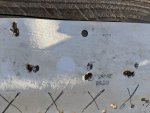Back story, since learning about OCW and Chris longs optimal barrel time, I seem to be collecting evidence that you can find relatively accurate loadings for most any charge by changing the lengths. It seems to be there are accurate nodes consolidated around different distances from the lands. I had found this from being forced to load to mag length for different calibers, then input from Scott Satterlee, and now a bit of research from SAC.
Trying to replicate the SAC test to find my OAL. It allows me to cover a lot of ground by loading one round each in .005" increments to see where this combo wants to shoot. I found my powder charge with an OCW test. I did not do a very controlled test, and made some errors in getting it set up. The attached picture is 4 different groups of 3 rounds each. The first group was 2 of the same length, and one .005 longer. The next 3 groups are a modified scope setting to come closer to point of aim (a mistake I believe for strictly placement comparison). Oddly enough the last 2 groups have lower placement, whic makes me think shooter error. I was after an OAL that was stable. It appears I have found that with the second group. This is roughly .090" off the lands. It seems the SAC test has worked for this rifle, to find a length to proceed at. Has anyone else tried this? What is the most efficient way to cover .100" of load testing to find a usable oal?
I generally never go inside .020" to the lands, and often find lengths quite a ways out that I run with. Let's hear about your OAL ideas.
Trying to replicate the SAC test to find my OAL. It allows me to cover a lot of ground by loading one round each in .005" increments to see where this combo wants to shoot. I found my powder charge with an OCW test. I did not do a very controlled test, and made some errors in getting it set up. The attached picture is 4 different groups of 3 rounds each. The first group was 2 of the same length, and one .005 longer. The next 3 groups are a modified scope setting to come closer to point of aim (a mistake I believe for strictly placement comparison). Oddly enough the last 2 groups have lower placement, whic makes me think shooter error. I was after an OAL that was stable. It appears I have found that with the second group. This is roughly .090" off the lands. It seems the SAC test has worked for this rifle, to find a length to proceed at. Has anyone else tried this? What is the most efficient way to cover .100" of load testing to find a usable oal?
I generally never go inside .020" to the lands, and often find lengths quite a ways out that I run with. Let's hear about your OAL ideas.

